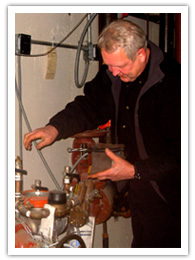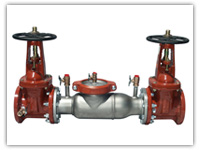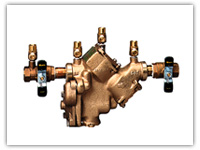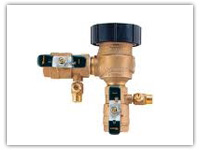The Backflow Prevention Learning Center
Pittsburgh Backflow Testing is committed to educating the Greater Pittsburgh area about what backflow is, how we can prevent backflow or back-pressure from contaminating our water supply and the different types of devices that are available to protect our homes and businesses.
WHY THIS IS IMPORTANT!
In order to ensure the quality of our drinking water, Congress passed the Safe Drinking Water Act in 1974 to protect the public health.
While our local water purveyors do an excellent job of providing clean and abundant drinking water to the Greater Pittsburgh region, they require help from all of the local businesses and residences that tie in to their water mains to maintain the integrity of that water supply. If just one business or residence were to unintentionally cause a backflow of contaminated water into the water distribution system that connects all of our homes, the potential harm to the community could be devastating.
That is why it is crucial that the community is educated on the importance of keeping our drinking water safe and clean for our children and future generations.
DEFINITIONS AND TERMS
BACKFLOW
The reversed flow of a non-potable source into a potable system, because a pressure differential exists where the pressure on the non-potable side is greater than the pressure on the potable side.
BACKFLOW PREVENTION ASSEMBLY
A mechanical device used to prevent the backward flow of contaminants or pullutants into a potable water distribution system.
CROSS-CONNECTION
Any arrangement of pipes, fittings, fixtures, or devices that directly or indirectly connects a non-potable water system to a potable water system.
CROSS-CONNECTION CONTROL
The use of assemblies, devices, methods, and procedures to prevent contamination or pollution of a potable water supply through cross-connections.
POTABLE WATER
Water that is safe for human consumption (meets the Safe Drinking Water Standards) and is aesthetically pleasing.
FREQUENTLY ASKED QUESTIONS
WHAT IS BACKFLOW?
Simply put, backflow occurs when a loss in water pressure (commonly due to a fire hydrant being opened, a water main break or simply abnormally high water usage) causes the water in your pipes to flow in the opposite direction. This occurrence could allow contaminated or polluted water to travel back into your drinking water.
WHAT IS A CROSS-CONNECTION?
Basically, a cross-connection is any real or potential  connection between the clean, public water supply and a source that can contaminate / pollute that water. Cross-connections can occur at both commercial and residential properties. For commercial customers, cross-connections exist in many forms; from carbonated beverage machines and ice-makers, to fire sprinkler systems and x-ray machines. It is not uncommon for a commercial property to have multiple cross-connections at their facility. On the residential side, the most common cross-connections occur with lawn irrigation and fire sprinkler systems. Perhaps the most frequently present cross-connection is the common garden hose, which when submerged in water, creates a dangerous path for contaminants to enter your drinking water.
connection between the clean, public water supply and a source that can contaminate / pollute that water. Cross-connections can occur at both commercial and residential properties. For commercial customers, cross-connections exist in many forms; from carbonated beverage machines and ice-makers, to fire sprinkler systems and x-ray machines. It is not uncommon for a commercial property to have multiple cross-connections at their facility. On the residential side, the most common cross-connections occur with lawn irrigation and fire sprinkler systems. Perhaps the most frequently present cross-connection is the common garden hose, which when submerged in water, creates a dangerous path for contaminants to enter your drinking water.
WHAT CAUSES BACKFLOW?
When there is a sudden drop in water pressure in your area (usually during the elimination of a fire, or concurrent use of large amounts of water by too many people at one time) the drop in pressure is what then pulls water that has already been expelled back into the main water supply.
HOW DOES BACKFLOW AFFECT ME?
 Out of sight, all of the water pipes entering your home, the restaurant down the street, and your local hospital, are all connected to the same water supply. In your residence or business, any mechanically-controlled use of water (ie: lawn irrigation, fire sprinkler system, pop machines, pedicure bowls, etc.) requires a backflow preventer as a necessary accessory to your plumbing system. A “backflow preventer” is just what it sounds like. Once water pressure drops, the backflow preventer seals shut, not allowing any water to flow backwards in the wrong direction.The EPA mandates that all backflow preventers be tested and certified once, sometimes twice per year, depending on the geographical location of the backflow preventer. If a water customer chooses not to meet this requirement, that customer will eventually be faced with the termination of their water service until they are able to show proof that their device has been properly tested and maintained. This annual or semi-annual testing is what ensures the safety of your drinking water.
Out of sight, all of the water pipes entering your home, the restaurant down the street, and your local hospital, are all connected to the same water supply. In your residence or business, any mechanically-controlled use of water (ie: lawn irrigation, fire sprinkler system, pop machines, pedicure bowls, etc.) requires a backflow preventer as a necessary accessory to your plumbing system. A “backflow preventer” is just what it sounds like. Once water pressure drops, the backflow preventer seals shut, not allowing any water to flow backwards in the wrong direction.The EPA mandates that all backflow preventers be tested and certified once, sometimes twice per year, depending on the geographical location of the backflow preventer. If a water customer chooses not to meet this requirement, that customer will eventually be faced with the termination of their water service until they are able to show proof that their device has been properly tested and maintained. This annual or semi-annual testing is what ensures the safety of your drinking water.
TYPES OF BACKFLOW PREVENTERS
DOUBLE CHECK VALVE ASSEMBLY

The Double Check Valve Assembly consists of two internally loaded, independently operating check valves together with tightly closing resilient seated shut-off valves upstream and downstream of the check valves. Additionally, there are resilient seated testcocks for testing of the assembly. The DC may be used to protect against a pollutant only. However, this assembly is suitable for protection against either backsiphonage or backpressure.
REDUCED PRESSURE PRINCIPLE ASSEMBLY

This assembly consists of two internally loaded independently operating check valves and a mechanically independent, hydraulically dependent relief valve located between the check valves. This relief valve is designed to maintain a zone of reduced pressure between the two check valves at all times. The RP also contains tightly closing, resilient seated shut-off valves upstream and downstream of the check valves along with resilient seated testcocks. This assembly is used for the protection of the potable water supply from either pollutants or contaminants and may be used to protect against either backsiphonage or backpressure.
PRESSURE VACUUM BREAKER

The PVB includes a check valve which is designed to close with the aid of a spring when flow stops. It also has an air inlet valve which is designed to open when the internal pressure is one psi above atmospheric pressure so that no non-potable liquid may be siphoned back into the potable water system. Being spring loaded it does not rely upon gravity as does the atmospheric vacuum breaker. This assembly includes resilient seated shut-off valves and testcocks. The PVB must be installed at least twelve (12) inches above all downstream piping and outlets. The PVB may be used to protect against a pollutant or contaminant, however, it may only be used to protect against backsiphonage. It is not acceptable protection against backpressure.
To access the original content, including additional educational resources, please visit backflow.com.
